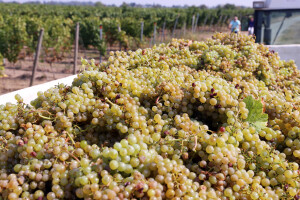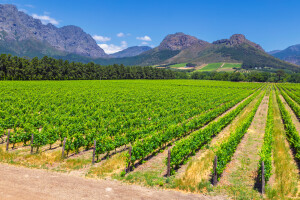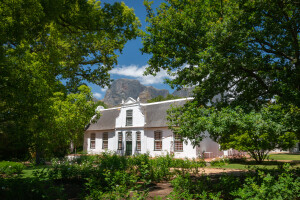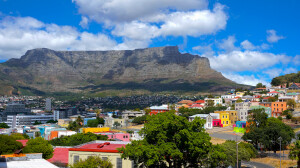Today we have a guest post from Jim Clarke, U.S. Marketing Manager for Wines of South Africa. Jim gives us a preview of his upcoming presentation, “In the Shadow of Chenin.” This session will be presented at the 46th Annual Conference of the Society of Wine Educators. The conference is scheduled for August 10-11 in Coachella Valley (Indian Wells, CA).
Across the U.S., in bistros and other places with smaller wine lists, if there’s only one South African wine included, it’s likely to be Chenin Blanc; the grape has definitively taken up a position as South Africa’s flagbearer. But on retail shelves and other spots with a little more room, many other South African wines are finding homes as well.
Among the more planted varieties Sauvignon Blanc, which makes up more than ten percent of South Africa’s vineyards, has enjoyed a two-side role in the U.S market. Imports are strong, but largely in the form of lower-tier brands that are not necessarily marketed as South African. Meanwhile, restaurant wine directors have increasingly realized that an old cliché about South African wine, that it’s “a little bit Old World, a little bit New” rings particularly true with Sauvignon. It doesn’t have the full, in-your-face tart fruit and grass of a Kiwi version, but it’s also more expressive than the citrus and mineral expressions of Sancerre. This makes it a great by-the-glass wine in markets where both those styles are popular, and this saves restaurants from having two Sauvignon Blancs open and losing their freshness. As the popularity of Sauvignon Blanc continues to grow, and especially in response to recent supply issues, these quality-driven South African Sauvignon Blancs are expanding their place in the market.
Back in South Africa more and more premium versions are appearing as more maritime areas focus their attention on the grape. Constantia and Durbanville, both a short drive from Cape Town, have made it a specialty, as has Darling, further up the West Coast. Some of the fastest growing areas for Sauvignon Blanc are in the Cape South Coast region, an area little explored for winegrowing at all until deregulation in 1992 removed a quota system that largely forbid planting there. Within the region Elgin is South Africa’s coolest climate winegrowing area, but Sauvignon Blanc plantings dot the coast all the way down to Elim in Cape Agulhas, the southernmost tip of the African continent. These windswept vineyards produce intense Sauvignon Blancs with a strong saline character.
Chardonnay falls in line just behind Sauvignon Blanc as South Africa’s fourth most-planted white variety, but emerged almost out of nowhere in the 1970s, when there were less than 6,000 Chardonnay vines in the whole country. It was heavily associated with the estate producers who drove quality production as the country emerged out of apartheid in the 1990s and has increasingly lived up to their aspirations. Relatively small appellations like Elgin and Hemel-en-Aarde have earned outsized reputations for their Chardonnays, but so has Stellenbosch, a much larger region with corresponding more hectares of the grape.
As in other places around the world, South African Chardonnay endured a phase where oak and weight showed more in the glass than the quality and character of the fruit, but that has since passed, a process accelerated by the poor state of the South African rand; imported oak barrels have become prohibitively expensive, leading South African producers to scale back new oak use and explore alternative aging vessels. The resulting wines are more balanced and elegant, but still offer a pleasing weight and texture on the palate. Together with Chenin Blanc, South African Chardonnay demonstrates winemakers’ interest in developing mouthfeel and texture in white wines without sacrificing freshness. This is particularly true with the country’s unoaked Chardonnays. Unoaked New World Chardonnay is often a light, crisp affair, but careful control of the fermentation process and lees work lend South African examples great presence on palate. The resulting wines can still appeal to more traditional Chardonnay fans while often eliciting a response from others along the lines of, “I don’t normally care for Chardonnay, but this!”
If you’re paying attention, you’ll notice we’ve skipped a grape somewhere. Chenin Blanc is South Africa’s most planted grape, and Sauvignon Blanc and Chardonnay rank third and fourth among whites. Quietly occupying the number two spot is Colombard. Varietal examples are rarely seen, however, as much of the grape goes either into bulk wine or brandy production. That is changing, and a handful of exciting examples of premium Colombard have begun to appear, especially from old vine vineyards where yields have dropped and the fruit is more concentrated. The wines are often lighter-bodied and more aromatic than the country’s Chenins and Chardonnays, but display depth and a rounded, pearly texture. There are also a few exciting examples of Colombard being used as a base for Cap Classique – traditional method sparkling wine – and a few experts have suggested this could become an intriguing niche within the fast-growing Cap Classique category.
There’s beyond Chenin, and there’s also beyond the top four planted varieties we just looked at. As winemakers explore further they’re considering and embracing a number of other varieties, mostly of Mediterranean origin. For now, these plantings are small – grapes like Clairette Blanche and Grenache Blanc occupy less than two percent of the country’s vineyards – but there are plenty of alternative varieties for the curious wine drinker to explore.
Jim’s session—In the Shadow of Chenin—is scheduled for Thursday, August 11th at 8:45 am as part the 46th Annual Conference of the Society of Wine Educators, to be held August 10-11 in Coachella Valley (Indian Wells, CA).
About the speaker: Jim Clarke is the U.S. Marketing Manager for Wines of South Africa. Prior to joining WOSA in 2013 Jim was the wine director at Armani Ristorante and Megu, both in New York City. He is also a writer, regularly contributing to a number of trade and consumer publications including World of Fine Wine, Club Oenologique, and Fortune. In 2020 Jim received the International Louis Roederer Wine Writer Award for Feature Writing and in August of that year Wine Business Monthly named Jim as a Wine Industry Leader of the Year. Jim is the author of The Wines of South Africa, published by Infinite Ideas as part of the Classic Wine Library in July 2020.



